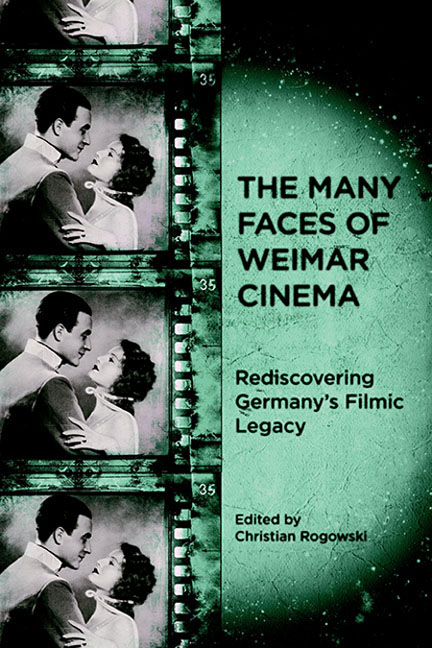Book contents
- Frontmatter
- Contents
- List of Illustrations
- Preface
- Introduction: Images and Imaginaries
- 1 Richard Oswald and the Social Hygiene Film: Promoting Public Health or Promiscuity?
- 2 Unsettling Nerves: Investigating War Trauma in Robert Reinert's Nerven (1919)
- 3 Humanity Unleashed: Anti-Bolshevism as Popular Culture in Early Weimar Cinema
- 4 Desire versus Despotism: The Politics of Sumurun (1920), Ernst Lubitsch's “Oriental” Fantasy
- 5 Romeo with Sidelocks: Jewish-Gentile Romance in E. A. Dupont's Das alte Gesetz (1923) and Other Early Weimar Assimilation Films
- 6 “These Hands Are Not My Hands”: War Trauma and Masculinity in Crisis in Robert Wiene's Orlacs Hände (1924)
- 7 The Star System in Weimar Cinema
- 8 Schaulust: Sexuality and Trauma in Conrad Veidt's Masculine Masquerades
- 9 The Musical Promise of Abstract Film
- 10 The International Project of National(ist) Film: Franz Osten in India
- 11 The Body in Time: Wilhelm Prager's Wege zu Kraft und Schönheit (1925)
- 12 Henrik Galeen's Alraune (1927): The Vamp and The Root of Horror
- 13 The Dialectic of (Sexual) Enlightenment: Wilhelm Dieterle's Geschlecht in Fesseln (1928)
- 14 Babel's Business — On Ufa's Multiple Language Film Versions, 1929–1933
- 15 “A New Era of Peace and Understanding”: The Integration of Sound Film into German Popular Cinema, 1929–1932
- 16 Landscapes of Death: Space and the Mobilization Genre in G. W. Pabst's Westfront 1918 (1930)
- 17 Undermining Babel: Victor Trivas's Niemandsland (1931)
- 18 Unmasking Brigitte Helm and Marlene Dietrich: The Vamp in German Romantic Comedies (1930–33)
- Filmography
- Notes on the Contributors
- Index
11 - The Body in Time: Wilhelm Prager's Wege zu Kraft und Schönheit (1925)
Published online by Cambridge University Press: 29 April 2017
- Frontmatter
- Contents
- List of Illustrations
- Preface
- Introduction: Images and Imaginaries
- 1 Richard Oswald and the Social Hygiene Film: Promoting Public Health or Promiscuity?
- 2 Unsettling Nerves: Investigating War Trauma in Robert Reinert's Nerven (1919)
- 3 Humanity Unleashed: Anti-Bolshevism as Popular Culture in Early Weimar Cinema
- 4 Desire versus Despotism: The Politics of Sumurun (1920), Ernst Lubitsch's “Oriental” Fantasy
- 5 Romeo with Sidelocks: Jewish-Gentile Romance in E. A. Dupont's Das alte Gesetz (1923) and Other Early Weimar Assimilation Films
- 6 “These Hands Are Not My Hands”: War Trauma and Masculinity in Crisis in Robert Wiene's Orlacs Hände (1924)
- 7 The Star System in Weimar Cinema
- 8 Schaulust: Sexuality and Trauma in Conrad Veidt's Masculine Masquerades
- 9 The Musical Promise of Abstract Film
- 10 The International Project of National(ist) Film: Franz Osten in India
- 11 The Body in Time: Wilhelm Prager's Wege zu Kraft und Schönheit (1925)
- 12 Henrik Galeen's Alraune (1927): The Vamp and The Root of Horror
- 13 The Dialectic of (Sexual) Enlightenment: Wilhelm Dieterle's Geschlecht in Fesseln (1928)
- 14 Babel's Business — On Ufa's Multiple Language Film Versions, 1929–1933
- 15 “A New Era of Peace and Understanding”: The Integration of Sound Film into German Popular Cinema, 1929–1932
- 16 Landscapes of Death: Space and the Mobilization Genre in G. W. Pabst's Westfront 1918 (1930)
- 17 Undermining Babel: Victor Trivas's Niemandsland (1931)
- 18 Unmasking Brigitte Helm and Marlene Dietrich: The Vamp in German Romantic Comedies (1930–33)
- Filmography
- Notes on the Contributors
- Index
Summary
Exposed and naked is our thinking. Now we comprehend the body, uncaged and without veiling insinuations. Radiant bronze skin mirrors the light of the Olympian sun with the same pure sobriety as the sparkling pistons of clearly formed machines.
— Wolfgang Graeser, 1927
Outside: harmony and softness; inside: function and anatomy — that is becoming the formula. But now we see even more: consciousness instead of gesture. Instead of the limbs as a system of signals, instead of the modified semaphore-culture spawned by war, a corporal will. A body-culture.
— Fritz Giese, 1925
Champions of Weimar republicanism draped the postwar democracy in the mantle of poets and thinkers, harking back to the classic achievements of a nation of culture. But even as they did so, the citizens of the republic were going mad for prizefighters, revue girls, and recordsetting sprinters. Observers of the times framed the rising currency of and fascination with performing bodies as both symptom and catalyst of important shifts in interwar German life – and modernity generally. Wege zu Kraft und Schönheit (Paths to Strength and Beauty), which premiered on 16 March 1925 at Berlin's opulent Ufa-Palast am Zoo cinema, occupies an interstice between the dizzying expanse of Körperkultur (body culture) and those who sought to define it.
Paths to Strength and Beauty strikes today's eye as an unintentionally comic melange. One grins at the documentary images of the modern body beautiful, chuckles at the contrived sequences that admonish viewers to kickstart fitness regimens, and nearly guffaws at the hackneyed reenactments of grand physical achievements of ages past (classical Greece in particular). Weimar-era critics, however, took this film as an impressive and important part of an emerging body culture, the seriousness of which is reflected in the attempts of the authors quoted above to bring gravity to the discourse of the physical and rescue the body from its equation with superficies. “Unfortunately, body-culture is still too neglected in Germany, unlike in other nations,” wrote one reviewer in the Reichsfilmblatt. “This film will open the eyes of many people and show them the debt they have incurred to themselves.”
- Type
- Chapter
- Information
- The Many Faces of Weimar CinemaRediscovering Germany's Filmic Legacy, pp. 182 - 197Publisher: Boydell & BrewerPrint publication year: 2010

